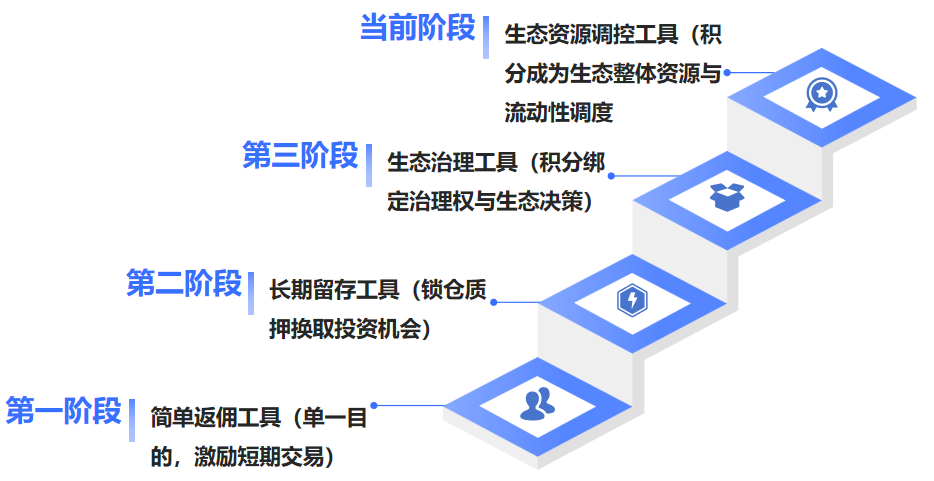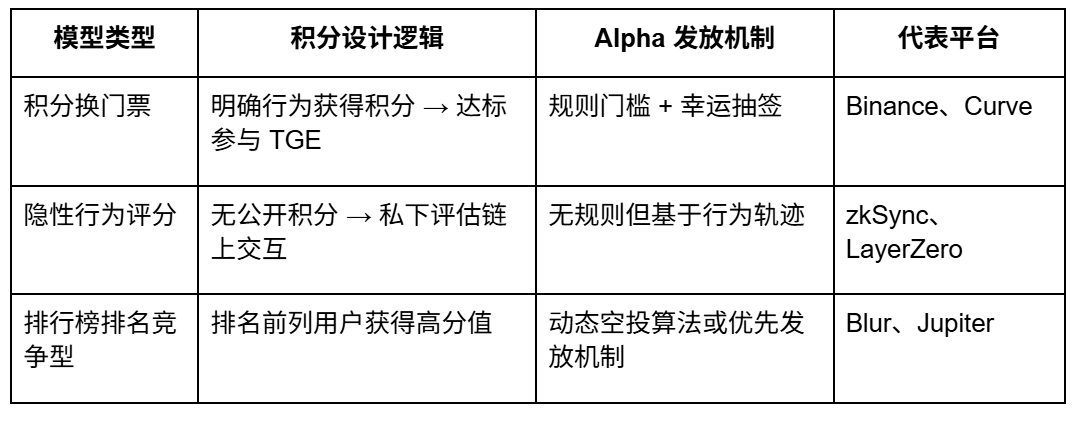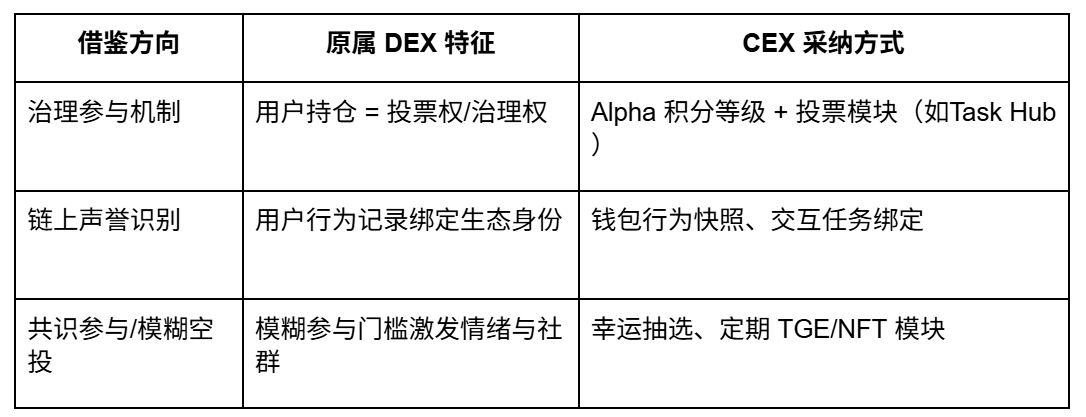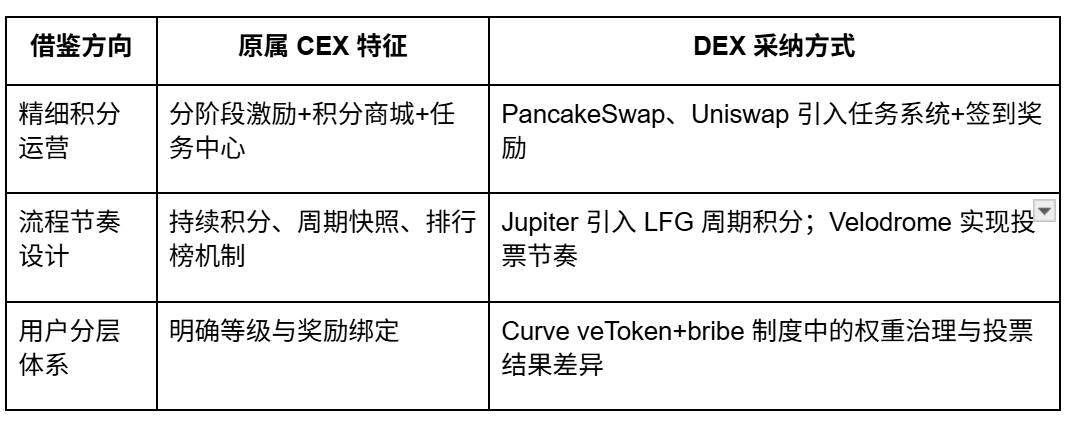From hair masturbation to identity: In the five years of Web3, how do you compete with points and Alpha?

Reprinted from panewslab
05/14/2025·0MMotivation becomes filter, points are no longer rewards, and Alpha is not just bait. Behind the mechanism, the platform is competing for users, and users are also building identities.
Introduction: Why are we so persistent about "points" and "Alpha"?
I don’t know when we seem to be particularly sensitive to “points” and “Alpha”.
The first thing we do when opening an exchange or DEX is no longer to find the next coin that can double, but to check whether the position of the points ranking has changed and whether there are new Alpha airdrop rules updated.
We began to carefully maintain our on-chain behavior records—even if we didn’t really know what points could be exchanged for, and we weren’t sure how Alpha airdrops would be distributed. But we still enjoy "scoring points" and "interaction" because we always feel that they will bring unexpected surprises one day.
Gradually we realize that the so-called "points" are no longer just transaction incentives, but a strategic leverage for the platform to dispatch assets and control users' attention; and "Alpha" is no longer just a vague investment space, it is becoming the strongest emotional driver in an ecological governance mechanism.
In the past five years, from CEXs such as Binance, OKX, Bybit, to DEXs such as Uniswap, Curve, and zkSync, the gameplay of points and Alpha has been constantly evolving: from the initial transaction rebate to today's ecological mechanism with community governance, resource regulation, and traffic screening as the core.
This "user growth game" game that seems to be composed of Alpha and points is actually reshaping the relationship between users, platforms and ecology, and each of us has long been in this game.
1. The essential evolution of the points mechanism—from rebate tools to
ecological scheduling system
In the early crypto ecosystem, whether CEX or DEX, points played a very simple role: increasing user transaction volume.
The initial trading points were very simple and crude. Exchanges represented by Bitstamp and Bitfinex only provide varying degrees of rebate or rate discounts based on the transaction volume. This design similar to "points" is intuitive and effective. Users can clearly see the direct economic benefits corresponding to each transaction, which is similar to "points" in form. Users can directly see the economic benefits brought by each transaction. But its flaws are also obvious: it cannot retain long-term users, and it cannot form real community stickiness. Users are more like profit-seeking traffic than co-constructors.
Alpha almost does not exist at this stage, or is just a vague "early investment opportunity" that fails to truly become the driving force for user growth.
1. From “Trading Rebate” to “Early Investment Tickets”
After 2017, with the emergence of Binance Launchpad, CEX linked points to "opportunity" for the first time: users obtained points through pledges or positions in exchange for qualifications to participate in high-quality project IDOs.
This design has changed the rules of the game: points are no longer just used to reduce handling fees, but become the stepping stone to the Alpha project -you have to accumulate assets and stay active in order to get the next wave of potential skyrocketing tickets.
Subsequent platforms such as OKX Jumpstart and Bybit Launchpad have copied this mechanism one after another. From then on, the points gameplay enters the "opportunity binding stage": it is no longer "give rewards", but "screening people".
2. From "screening people" to "empowerment governance"
The DEX ecosystem developed in parallel to it will reshape the meaning of points in a more radical way. Uniswap's UNI airdrop in 2020 is a real breakthrough in the points and the Alpha concept. It is not a simple rebate, but an active "incentive + governance" mechanism based on past on-chain behavior. Users no longer just receive short-term rewards, but become directly participants in protocol governance. Behind the points are the governance rights and decision-making rights of the on-chain community.
This transformation clarifies the strategic connotation of points: from simple transaction-driven to the core tool for ecological governance and community participation.
After 2021, this trend will deepen further. The veToken points model launched by Curve clearly allows points to directly determine governance rights and ecological benefits distribution; while the new generation of DEX represented by Raydium embeds points into the core process of project Launch and ecological startup. At this time, points are no longer an "accessor" to the platform, but a basic tool for project launch, community governance, and resource allocation in the Web3 ecosystem.
When we review the development history of this integral mechanism, we can clearly see its kernel evolution path:

Image source: Nomos Lab Compiled based on public information
Nowadays, both CEX and DEX are strategically designing points rules to regulate user attention, asset flow direction, and even the development trend of the entire ecosystem. The competition in the points mechanism is no longer a simple preferential game, but a real ecological war.
From simple "transaction incentives" to deep "ecological strategic weapon", the evolution path of points shows the profound changes in Web3 user growth strategies. This change is not only the result of user demand, but also the inevitable result of the continuous escalation of competition and game between platforms.
2. The alienation and coordinated evolution of the Alpha mechanism—from
fuzzy expectations to ecological drivers
If points are the "rules and order" formulated by the platform, then Alpha is the "emotional fuel" for user participation.
Points often have clear acquisition methods and redemption paths, while Alpha is driven by a vague but strong expectation to inspire users to continue to be active in the ecosystem, even if there is no "reward" at all.
It is not always bound to the points mechanism, and sometimes even outside the entire incentive system, but it can often create the strongest desire to participate and become the most core "non-institutional force" in platform growth.
**1. The psychological nature of Alpha: Fuzzy creates passion for
participation**
The charm of Alpha lies in “uncertainty.”
It is precisely because users don’t know whether Alpha airdrops are available, when and how to divide them, that they are more likely to actively participate, swipe interactions, and keep their assets active under the expectation of “maybe there”. This is a typical psychological game: vague hope is more traction than clear rules.
Blur is the most typical case. Although its early airdrop points mechanism has rankings, there are no clear redemption rules. Users are still willing to place orders, interact, and create transaction volumes in a crazy way -because they believe that as long as I am active, I may be rewarded.
This emotional drive constitutes the underlying power of Alpha.
2. Three mainstream Alpha models and evolutionary logic
(1) Narrative-driven Alpha: Rely on emotional consensus to drive participation
-
Representative projects: zkSync, StarkNet, Scroll
-
Mechanism features: There is no point system, and it only relies on the rumors that "may be airdropped" to stimulate user interaction on the chain
-
User behavior: Interaction ecology, register all projects, extremely scattered but highly continuous
(2) Points-linked Alpha: Use rules to bind to expect
-
Representative projects: Binance Alpha Points, Curve veCRV
-
Mechanism features: Alpha is clearly bound to points, and the points consumption is redeemed for TGE quota or empty investment space
-
User behavior: Actions around points tasks, with high concentration of assets and behaviors and high competition intensity
(3) Behavior capture type Alpha: no rules but highly effective
-
Representative projects: LayerZero, Blur
-
Mechanism features: There is no formal points system, but user behavior data is secretly recorded and affects the empty investment space
-
User behavior: "self-design behavior trajectory" around interaction, but the input-output ratio cannot be determined
3. Alpha 's game risks: overstimulation and behavioral alienation
Although the ambiguity of Alpha can stimulate enthusiasm, it can also easily create problems such as short-term arbitrage and ineffective brushing.
Blur's initial order brushing problems, zkSync's large number of low-quality interactions, LayerZero's accused of over-guiding the "interaction farm", etc., all exposed a core problem:
When Alpha is no longer scarce and becomes the norm of "as long as there is interaction", it loses its screening value and pollutes the ecology.
Therefore, the platform began to try to use the combination mechanism of "points + Alpha" to perform more refined control.
4. Alpha and Points: A hybrid mechanism of co-evolution
A single mechanism is no longer enough to meet the needs of ecological management. So, the platforms began to explore "dual-track drive":
The advantages of the mechanism, the best way to play the role of the points, clear rules, easy to be brushed, form the volume of the inversion as the basic structure and screening threshold Alpha stimulates enthusiasm, strengthens user participation expectations instability, and induces promiscuous interaction as additional rewards and emotional drivers
The goals of the hybrid mechanism are:
-
Use points to "regulate behavioral paths" to avoid systemic abuse;
-
Use Alpha to "create vague expectations" to inspire long-term enthusiasm for participation.
This strategy is adopted by the Binance Alpha Points model:
-
Set points acquisition rules and consumption thresholds (institutionalized control);
-
Introduce lucky mechanisms and special conditions (emotional selection);
-
And control the release rhythm and difficulty in each Alpha project to achieve the dual goals of traffic management and user filtering.
**5. Alpha 's new function: becoming a "vote" of on-chain narrative and
ecological identity**
Alpha's evolutionary path is gradually changing from "reward" to "identity symbol".
In ecology such as zkSync, LayerZero, users not only interact for short-term airdrops, but hope to be identified as "ecological co-builders" or "long-term participants". Alpha began to become an indirect credential for on-chain reputation and governance rights.
-
Blur launches points consumption mechanism after airdrop: encourage long-term activity rather than one-time rush
-
Binance Alpha sets points retention threshold and random conditions: filter loyalty rather than arbitrage users
-
LayerZero starts to identify the "real interaction path" and sets up a behavioral anti-cheating system
Together, these changes point to a trend:
Alpha is becoming the most differentiated and symbolic "value distribution logic" in the on-chain ecosystem.
3. Points × Alpha——User control system under dual-track drive
The growth mechanism of the Web3 world is entering a "dual-track drive" stage: institutional points system and fuzzy Alpha rewards have begun to be consciously combined to form a strategic tool that runs through user acquisition, behavioral guidance, asset precipitation and rhythm management.
In the past, points and Alpha were two parallel worlds: one was a clear rule and quantifiable participation structure; the other was to mobilize users' subjective imagination with vague and uncertain expectations. But today, they no longer separate, but rely on each other to build a new user behavior operating system.
The first thing I realized was Binance. In its Alpha Points mechanism, the points acquisition rules are designed to be extremely finely designed: users obtain points through trading, holding positions, and participating in activities; at the same time, the system sets qualification thresholds of different levels in exchange for priority subscription rights or empty investment spaces for specific TGE projects. But what really drives users to "scort" crazy is not the direct purpose of these points, but the suspenseful Alpha behind it - that is, the airdrop that you may get if you have enough points, but you may also miss it.
This fuzzy boundary design greatly stimulates users' enthusiasm for participation. For example, in DOOD airdrop, users with 168 points or above will be directly qualified, while users with 129 to 167 points will need to rely on the UID last number to win the lottery. This subtle "fuzzy interval" allows a large number of users to actively increase interaction and increase scores to avoid falling into the "marginalized" risk zone.
The core of this mechanism is: points provide structure, and Alpha provides suspense; points are "what I did", and Alpha is "maybe there will be results"; points are bound to rules, and Alpha mobilizes psychology. When the two are integrated, the platform gains multiple control capabilities for users' attention, time, behavior and asset flow paths.

Image source: Nomos Lab Compiled based on public information
This structure not only optimizes the logic of user hierarchical screening, but also greatly improves the platform's ability to control rhythms within the ecosystem. Taking Blur as an example, he did not give any points redemption rules in the early stage, but through points rankings, behavior-linked scoring systems and other means, he successfully created the emotional guidance of "work will be seen", thus promoting continuous, high-frequency and high-cost participation by users.
This practice of using "fuzzy alpha" as the core of motivation is actually a deep utilization of user psychology: when the reward rules are opaque, users will invest more, because everyone believes that "maybe I can be selected." The existence of points has built a positive feedback framework for this fuzzy:
-
Points control behavior path: clarify incentive rules, guide users to lock their assets and participate for a long time;
-
Alpha provides emotional drive: create uncertainty, stimulate users to score points and improve stickiness;
-
Fusion point: Use the combination of "points snapshot + Alpha airdrop + consumption mechanism" to regulate rhythm and ecological load.
Ultimately, user behavior also changed. They no longer act just for "changing rewards", but participate in "leaving traces" and being recognized by the system. They build "points identity" on the platform, and bet on the cashing of a certain Alpha in the future. This "participation is candidate" mechanism transforms users from short-term actors to long-term asset co-builders.
What the platform hopes for is this silent binding.
4. The boundary of fusion—the mechanism interpenetration and competitive
reconstruction between CEX and DEX
As the dual-track mechanism of Alpha × integral is becoming more mature, another essential trend has begun to surface: the mechanism boundaries between CEX and DEX are rapidly blurring, and they learn from each other, learn from each other, and gradually integrate. In the past, we regarded the two as the opposing paradigm of "centralization vs. decentralization", but now, they are all moving towards the same goal - building a more stable user participation system and ecological collaboration mechanism.
First of all, CEX leans into DEX's governance concept. Platforms such as Binance, OKX, and Gate are no longer satisfied with the traditional task center + rebate points design, and have begun to introduce concepts such as on-chain behavior snapshots, on-chain wallet binding, and task structure hierarchy, and build user level and points growth paths through these on-chain interaction traces. For example, Binance introduced the "Web3 wallet binding + on-chain task participation" rule in Alpha Points, which essentially identify "trusted users" through on-chain behavior and create a DEX-style "reputation distribution".
At the same time, these platforms have gradually added light governance modules, such as user voting and coin listing (such as Gate Startup), activity voting (such as OKX voting list), and began to build a path of "user consensus → behavioral value", which essentially borrowed the governance participation structure of DEX.

Image source: Nomos Lab Compiled based on public information
At the same time, DEX is also quietly moving closer to CEX. New generation DEXs such as Uniswap, PancakeSwap, Jupiter, and Velodrome have begun to introduce institutionalized operation modules such as points system, task structure, phased airdrop, ranking mechanism, and periodic liquidation.
Jupiter's LFG system is a typical "ranking + points reset + cycle loop" CEX operation model. Velodrome realizes a combination strategy of governance voting and incentive allocation through veNFT and bribe mechanisms, and builds an orchestable points path of "user behavior + governance incentive". Uniswap is promoting the cross-protocol structure of "on-chain identity + multi-chain points" and is constantly evolving in operational accuracy.

Image source: Nomos Lab Compiled based on public information
More importantly, user behavior has also changed in the integration of the two types of platforms.
They no longer simply “select the platform”, but “select the mechanism”: whether there are reasonable points rules, whether vague but real Alpha rewards are provided, and whether there are identifiable trajectories. The units that compete on the platform are no longer "number of users", but "mechanism design capabilities" - whoever can build a smoother incentive structure and accumulate a higher quality user path will have a better chance of winning the ecological dominance in the future.
Points and Alpha are becoming the "mechanical language" in this competition.
The past traffic battle is transforming into a mechanism design war, while platform governance, community control, and user stickiness are moving towards the next stage of deep structure through this integration.
Chapter 5: After points, the battle of mechanics has just begun
We once thought that points are a promotional prop, giving users some benefits, bringing new things, stabilizing transaction volume, and completing tasks. But looking back now, this understanding is too shallow.
In today's Web3 world, the gameplay of points and Alpha is no longer a superficial incentive structure, but has become a gaming interface for cognition and power between the platform and users.
On the one hand, the platform uses the points system to finely set the user's behavior track - what is worth doing, when and how much to do it is considered "qualified"; on the other hand, it uses the vague Alpha mechanism to create "maybe" expectations, which continues to arouse your emotions of participation.
This mechanism is very clever because it does not require you to know what you will get right now, you just need to believe that it is worth staying.
And just as this set of narrative logic is gradually set, new changes are beginning to brew.
We are standing at a juncture of “Mechanism Integration → Mechanism Leap”. The next game will no longer be just "what you did", but what traces you left in whose system.
Future points may no longer be as simple as "trading volume × weight", but are composed of multiple variables:
-
Which links have you interacted in?
-
How many ecological governance have you participated in?
-
Do you have a complete and coherent on-chain behavior trajectory?
-
Are you doing the ranking task or actually participating?
In other words, points are not just "evidence of behavior", but become the way the ecology understands your value.
And this understanding will no longer be limited to a single platform.
We can see some signs:
zkSync's airdrop introduces "average asset retention time" when calculating interactions; LayerZero's points system has long secretly recorded the chain and depth of your participation; "on-chain identity protocols" such as Sismo and Gitcoin Passport have begun to be adopted on multiple platforms, becoming your "or is a real user" ID card.
Perhaps in the near future, the points of different platforms will no longer compete with each other, but will form a "trust network" that recognizes across ecology: if you have interacted in LayerZero, zkSync will reduce you a little bit of threshold; if you have participated in the governance of a certain DAO, Blur may be willing to give you a whitelist directly.
At that time, we were not facing "how many points are obtained", but "how do we think of me in the entire Web3".
On the other hand, the platform also began to get nervous.
While ambiguity brings high participation, regulatory uncertainty is also beginning to approach:
Do points belong to assets? Does Alpha constitute disguised financing? If the purpose of a points system is to eventually airdrop tokens to users, does it need to publicly disclose the distribution logic? Is compliance risks involved?
So you will see more and more platforms becoming "fuzzy and restrained": you don't give you a formula that you understand too much, don't tell you directly "what points can be exchanged for?" Everything is just a "reference", and everything must be "official follow-up notice".
It seems to be "keep mystical", but it is actually "avoiding responsibility".
And the end of this fuzzy battle is likely to be: users are becoming smarter and platforms are becoming more and more careful.
Therefore, the truly effective mechanism will no longer be "stimulating brush interaction", but designing a participation structure that allows users to stay and deserve to be identified. It’s not that people give up points, but that they are willing to build together.
This mechanism is not just an operational means, but an ecological order itself.
At the end: What you're trying to get is not just points, but who you are
Points seem to be rewards, but in fact they are records of "you have participated" again and again.
Alpha seems to be an airdrop, but in fact it is a signal of "you are seen".
Looking back at the entire evolutionary process, from Bitfinex's rebate system, to Binance's Launchpad, from Uniswap's UNI airdrop, to Curve's veToken decision-making power, and then to LayerZero, Jupiter, and zkSync's user identification algorithms, we have seen clearly:
Users are not left behind by incentives, but by mechanism recognition.
And we have long evolved from a "hair-fighting party" to a "candidate".
We participate in interactions not for short-term gains, but for building an identity and an image that can be seen by the ecology.
What we get is not just points, but the kind of person we are willing to be. What we bet on is not just about Alpha, but about our belief that a certain mechanism is worth participating in and co-construction.
The battlefield between platforms has also changed from "whoever drops more airdrops" to "whoever system can keep people."
From traffic competition to structural competition.
From motivational game to identity construction.
From points game to order design.
We will eventually forget how many points are and what Alpha gives.
But we will remember: which platform once really saw me.
Reference source
-
CoinMarketCap. ( 2024 ). The evolution of decentralized exchanges.
-
GlobeNewswire. ( 2024, September 17). Bybit Web3 makes WSOT debut: DEX Wave featuring over 100 DeFi partners in Web3's first idol competition.
-
NFTEvening. ( 2025, April). Understanding Binance Alpha Points: A guide to earning rewards.
-
ODaily. ( 2025, February). DEX points essentials: Opportunities and challenges in Web3.
-
ODaily. ( 2025, March). Web3 points wars: Trends and user engagement strategies.
-
ODaily. ( 2025, April). Binance Alpha ecosystem: TGEs and points-driven growth.
-
Panews. ( 2024, October). Bybit WSOT DEX Wave: Voting mechanisms and liquidity boost.
-
Panews. ( 2024, December). OKX Jumpstart: Staking mechanisms and accessibility challenges.
-
Panews. ( 2025, January). Gate.io Startup and task center: Points for new users.
-
Panews. ( 2025, March). Web3 points wars: A comparative analysis of major platforms.
-
Panews. ( 2025, April). Binance Alpha Points: Mechanics and market impact.
-
TheBlockBeats. ( 2024, November). Uniswap's multi-chain points plan: Scaling DeFi incentives.
-
TheBlockBeats. ( 2025, February). PancakeSwap's voting points: Governance and resource allocation.
-
TheBlockBeats. ( 2025, April). Binance TGE airdrops: Attracting investors in 2025.
-
Thirdweb. ( 2024). Web3 loyalty programs: NFTs and points interoperability.

